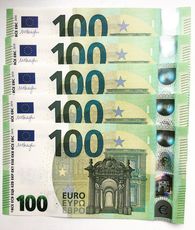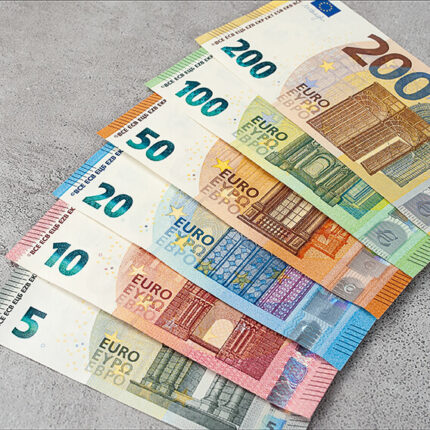Buy 20 Euro Banknote Online
The 20 Euro banknote is one of the widely circulated denominations of the Euro currency, used across the Euro-zone. Like other Euro notes, it includes various security features to prevent counterfeiting. Here is an in-depth look at the 20 Euro note:
Design of the 20 Euro Banknote:
1. Front (Obverse):
- Architectural Theme: The 20 Euro note features Gothic architecture from the 12th to 16th centuries, symbolizing Europe’s architectural heritage. The design includes an image of a large Gothic window or doorway, representing openness and progress.
- Color Scheme: The primary color of the 20 Euro note is blue, making it visually distinct from other denominations.
2. Back (Reverse):
- Bridge Image: The reverse side of the note shows a Gothic-style bridge, symbolizing the connection and communication among European nations.
Security Features:
The 20 Euro note is packed with security features that help detect counterfeit notes and protect the currency from fraud. These features include both visible and hidden elements, which are easy to check and difficult to replicate.
1. Holographic Stripe:
- A holographic stripe runs vertically down the right side of the note. When tilted, it alternates between the value of the note (“20”) and a window or doorway image, with a rainbow effect that confirms its authenticity.
2. Watermark:
- When held up to the light, a watermark of Europa, a figure from Greek mythology, appears along with the denomination of the note (“20”). The watermark is visible from both sides of the note.
3. Security Thread:
- A security thread is embedded in the note, running vertically. It appears as a dark line when the note is held to the light. The text “20 EURO” and the Euro symbol (€) are microprinted on the thread. Under UV light, the thread becomes more apparent.
4. Emerald Number:
- The large number “20” in the lower left corner is printed using color-shifting ink. When the note is tilted, this number changes from emerald green to deep blue, providing a quick way to check for authenticity.
5. Microprinting:
- Detailed microprinting of tiny letters and numbers can be found in various areas of the note. These are difficult to replicate and can only be seen under magnification, making them an important anti-counterfeiting measure.
6. Ultraviolet (UV) Features:
- Under UV light, several features of the 20 Euro note become visible:
- The EU flag with its stars glows yellow.
- Small fibers embedded in the paper glow in red, blue, and green.
- The serial number and other design elements, such as parts of the bridge, also glow under UV light.
7. Raised Printing:
- Parts of the note, such as the large number “20”, the word “EURO”, and the architectural design, are printed with raised ink, which can be felt by touch. This helps visually impaired individuals to identify the denomination and also provides a tactile way to verify authenticity.
8. Portrait Window (Europa Series):
- The Europa series version of the 20 Euro note includes a transparent portrait window near the hologram. When the note is held up to the light, the window reveals a portrait of Europa, visible from both sides. This feature offers an added layer of protection against counterfeiting.
9. Size:
- The 20 Euro note measures 133 mm x 72 mm (5.2 inches x 2.8 inches), slightly larger than the 10 Euro note but smaller than the 50 Euro note. The size of Euro notes increases with the denomination.
Features for the Visually Impaired:
The 20 Euro note, like all Euro banknotes, includes specific features to assist the visually impaired:
- Raised lines on the sides of the note allow tactile identification.
- The color and size of the note help distinguish it from other denominations.
Durability:
- The 20 Euro note is printed on high-quality cotton paper, which gives it a distinct feel and durability. The Europa series introduced improvements in durability, making the note more resistant to wear and tear.
Historical Context:
The Euro currency was first introduced in 2002, and the 20 Euro note was part of the initial banknote series. In 2015, the Europa series 20 Euro note was issued with enhanced security features, including the portrait window and an upgraded holographic stripe.
Counterfeiting and Detection:
To verify the authenticity of a 20 Euro note, you can follow these steps:
- Feel the Raised Ink: Rub your fingers over the raised printing, especially on the large “20” and the text “EURO.”
- Check the Watermark: Hold the note up to the light to see the watermark of Europa and the value “20.”
- Tilt the Note: Tilt the note to see the emerald number change from green to blue and observe the shifting holographic elements.
- Inspect Under UV Light: Use a UV light to check for glowing fibers, the EU flag, and other ultraviolet features.
Conclusion:
The 20 Euro banknote is a highly secure and durable currency note with a range of advanced features. Its design reflects Gothic European architecture, symbolizing the cultural heritage of Europe, while its security elements, such as the holographic stripe, watermark, and portrait window, make it difficult to counterfeit. It is an essential denomination in everyday transactions across the Eurozone.










David –
Vielen Dank, Sir, ich habe mein Paket direkt vor meiner Haustür erhalten. Sie sind echt, ohne Zweifel, vielen Dank
Cerobeh ilijic –
Ich kann diese Website jedem wärmstens empfehlen, der nach einem besseren Verkäufer sucht
Melissa –
Ich wurde von einem Freund empfohlen, wie viel kann ich mit 500 bekommen
Janet –
🥰